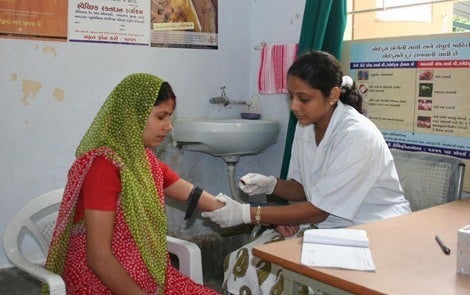Experts discuss similarities, differences between U.S., India health systems

December 14, 2012 — It should come as no surprise that the health care systems of the United States and India differ in many ways, but what may be surprising is the amount they have in common.
This fact—and what each country can learn from the other as it pursues improvements in health care—was the subject of a talk at Harvard School of Public Health (HSPH) on Wednesday, December 2, 2012, featuring [[Ashish Jha]], associate professor of health policy at HSPH and a practicing physician, and K. Sujatha Rao. Rao is a former secretary of health and human welfare in India (2009-2010) and director-general of the National AIDS Control Organization (2006-2009). After finishing her official career with the Indian Administrative Service two years ago, Rao spent three months at HSPH in spring 2012 as a senior leadership fellow in the Division of Policy Translation and Leadership.
“It’s striking to me how similar these two countries’ health care systems are—the two largest democracies in the world—and how different their health care systems are,” Jha told the audience in Kresge 110. “They both have a mix of private and public, in terms of the delivery side as well as the payment side. And they’re both at inflection points, where there are important policy decisions being made about what the next 5 to 10 years will look like for the health care system.” The Indian government is about to make a major investment in health care, he said. And, in the United States, the passage of the Affordable Care Act represents a major investment on the part of the federal government.
One big difference? India spends about $40 per person annually on health care; the United States spends $8,500. The entire GDP of India is $1.6 trillion; U.S. health care spending alone is $2.6 trillion. “What is very interesting is that India spends so little, but there are hospitals there that are comparable in terms of outcomes,” noted Rao.
Similarities: decentralization, influence of private sector
India has a decentralized public health care system, run largely by its 28 states and seven territories. The central government’s only constitutional mandate is to oversee medical education and collect infectious diseases statistics, Rao said. Health care quality and access in rural areas lag far behind that of cities. To boost health care throughout the nation, the central government—with its tax-collecting powers and therefore greater financial resources—provides support for the states while nudging them to make improvements. Rao said there is ongoing debate in India about how much power the central government should have in overseeing health care and how much the states should have.
After Rao’s description of the Indian health care system, Jha asked the audience, “Does this sound like the United States?” Rao and Jha went on to note some of the other similarities between the two systems. In both countries, special interest groups—high-paid doctors, hospitals, insurance companies, drug companies—lobby politicians for health care policies that will be advantageous to them. One audience member commented, “People with more money have more voice. It’s always the same.”
Rao observed that the corporate sector in India is expanding to gain market depth in the health care area through mergers, acquisitions, or franchising. If unregulated, she said, these corporate moves could undermine the benefits provided by smaller operations—like nursing homes, family-run physician practices, or nonprofit hospitals—which are typically run simply and inexpensively.
Differences: public health, social solidarity
One of the biggest differences between the United States and India is in the public health arena. “There’s not enough spent on safe water, sanitation, and nutrition,” Rao said of her country. “Only 25% of the population has access to sanitation. At a human level, this is a real problem.”
Part of the problem, she thinks, is that India lacks “social solidarity”—a sense that people should take care of other people—and this has resulted in a health system rife with inequities. Rao wondered aloud whether it makes sense for India to take lessons from the United States, given its own struggles to fashion an effective health care system. But she concluded, “I feel you have a lot to teach us—both for your mistakes and for the things you do right.”
photo: Rajal Thaker, courtesy Photoshare
Learn more
Watch Voices from the Field video featuring K. Sujatha Rao
Inaugural HSPH leadership fellows share real-world public health policymaking expertise (HSPH feature)


